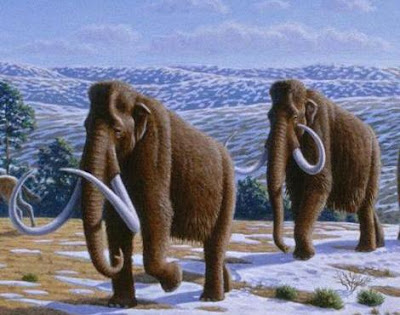Animals Unique | Woolly Mammoth | The Woolly mammoth was an enormous mammal That once roamed the the vast frozen, northern landscapes in large size. Believed to be closely related to the modern-day elephant, the Woolly mammoth remained in the wild until roughly 1700 BC when it Became extinct.
The Woolly mammoth was found roaming the bitter Arctic tundra where They would gather in large herds Often for both warmth and protection. Woolly mammoths lived in the which two groups are thought to have been different enough to be characterized as separate subspecies. Woolly mammoths One group stayed in the middle of the high Arctic, while the other group Woolly mammoths had a much Wider range.
The Woolly mammoth was an enormous animal, with adults reaching heights of four Often meters or more. Woolly mammoths in Certain areas where, on average slightly smaller in size and Could in fact be just half the size of one of the largest individuals Woolly mammoths.
As elephants do today, the Woolly mammoths had enormous Tusks the which would have been used for both digging and collecting food, and for both intimidating and fighting off predators and rivals. The Tusks of the Woolly mammoths were quite Dramatically Often Could easily be curved and up to 5 meters (16ft) long.
Like the African and Asian elephants still found roaming the small parts of the planet today, the Woolly mammoth was a herbivorous animal it survived That meaning on a purely plant-based diet. Woolly mammoths would have eaten vegetation similar to modern-day elephants, forests for browsing the leaves, fruits, nuts, Twigs and berries.
The Woolly mammoth was an enormous animal, with adults reaching heights of four Often meters or more. Woolly mammoths in Certain areas where, on average slightly smaller in size and Could in fact be just half the size of one of the largest individuals Woolly mammoths.
As elephants do today, the Woolly mammoths had enormous Tusks the which would have been used for both digging and collecting food, and for both intimidating and fighting off predators and rivals. The Tusks of the Woolly mammoths were quite Dramatically Often Could easily be curved and up to 5 meters (16ft) long.
Like the African and Asian elephants still found roaming the small parts of the planet today, the Woolly mammoth was a herbivorous animal it survived That meaning on a purely plant-based diet. Woolly mammoths would have eaten vegetation similar to modern-day elephants, forests for browsing the leaves, fruits, nuts, Twigs and berries.
Due to the sheer size of the Woolly mammoth, it had only one real predator in it's natural environment was the which-toothed cats saber Often That would hunt the Woolly mammoth calves smaller. Other than human hunters wiped out the That Quickly Woolly mammoths Populations in the vast areas of the Arctic tundra, the rapidly melting ice had an enormous impact on Their demise.
Although little is really known about the reproduction of Woolly mammoths, it is quite Likely That in a similar way to elephants, the female Woolly mammoths would have given birth to a single Woolly mammoth calf after a nearly year long (maybe even longer) gestation period . Woolly mammoths are thought to have had quite a long lifespan, getting to an average of 70 years old.
Generally it was assumed the last Woolly mammoths That vanished from Europe and Southern Siberia in around 8.000 BC, with the last of the isolated Woolly mammoths from Wrangel Island Populations vanishing, located in the Arctic Ocean in around 1700 BC.
Although little is really known about the reproduction of Woolly mammoths, it is quite Likely That in a similar way to elephants, the female Woolly mammoths would have given birth to a single Woolly mammoth calf after a nearly year long (maybe even longer) gestation period . Woolly mammoths are thought to have had quite a long lifespan, getting to an average of 70 years old.
Generally it was assumed the last Woolly mammoths That vanished from Europe and Southern Siberia in around 8.000 BC, with the last of the isolated Woolly mammoths from Wrangel Island Populations vanishing, located in the Arctic Ocean in around 1700 BC.
Woolly Mammoth Facts
Kingdom: Animalia
Phylum: Chordata
Class: mammals
Order: Proboscidea
Family: Elephantidae
Genus: Mammuthus
Scientific Name: Mammuthus primigenius
Type: Mammal
Diet: Herbivore
Size (H): 1.8m - 4m (6ft - 13ft)
Weight: 8000kg (8.8tons)
Life Span: 60-80 years
Lifestyle: Herd
Conservation Status: Extinct
Extinct: 1,700 BC
Colour: Brown, Black, Tan
Skin Type: Hair
Favourite Food: Grasses
Habitat: Arctic Tundra
Average Litter Size: 1
Main Prey: Grasses, Twigs, rushes
Predators: Sabre-toothed cats and Humans
Distinctive Features: Long, thick hair and enormous Tusks
Kingdom: Animalia
Phylum: Chordata
Class: mammals
Order: Proboscidea
Family: Elephantidae
Genus: Mammuthus
Scientific Name: Mammuthus primigenius
Type: Mammal
Diet: Herbivore
Size (H): 1.8m - 4m (6ft - 13ft)
Weight: 8000kg (8.8tons)
Life Span: 60-80 years
Lifestyle: Herd
Conservation Status: Extinct
Extinct: 1,700 BC
Colour: Brown, Black, Tan
Skin Type: Hair
Favourite Food: Grasses
Habitat: Arctic Tundra
Average Litter Size: 1
Main Prey: Grasses, Twigs, rushes
Predators: Sabre-toothed cats and Humans
Distinctive Features: Long, thick hair and enormous Tusks



No comments:
Post a Comment